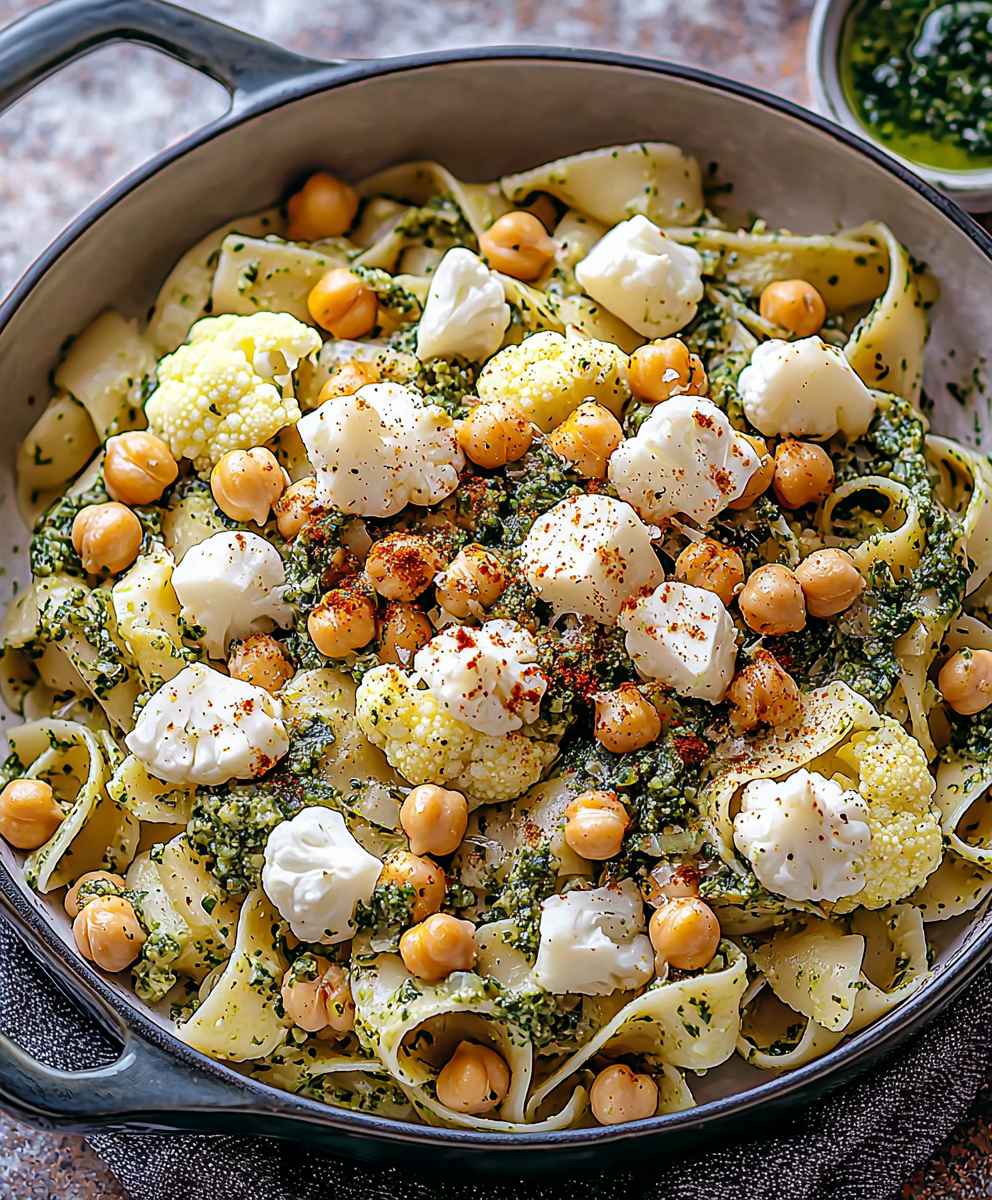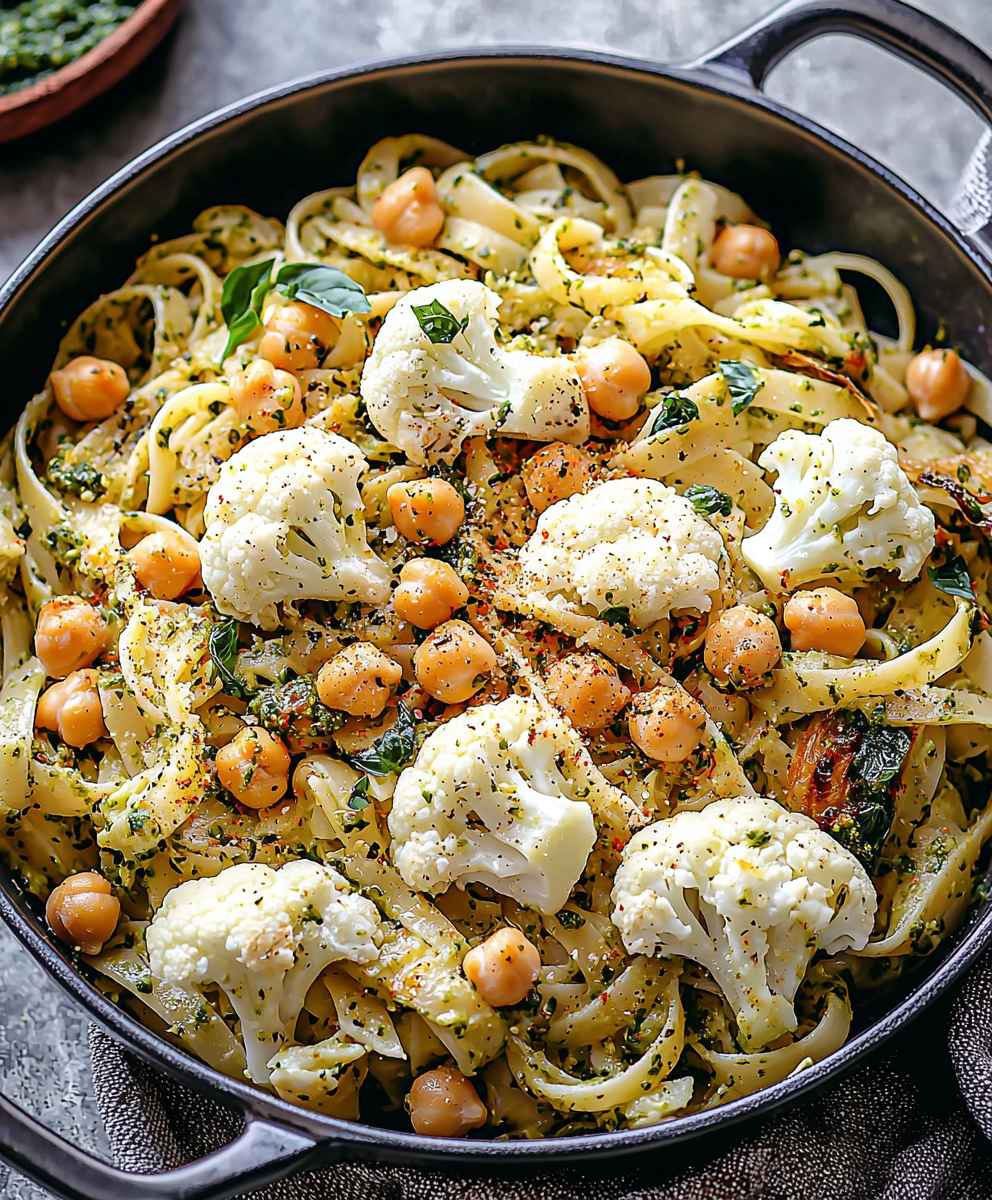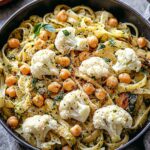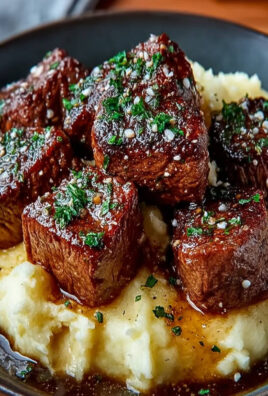Cauliflower Chickpea Pesto Pasta: Prepare to be amazed! This isn’t your average pasta dish; it’s a vibrant, flavorful explosion that will redefine your weeknight dinners. Imagine twirling your fork around perfectly cooked pasta, coated in a creamy, dreamy pesto sauce, studded with tender roasted cauliflower and hearty chickpeas. Sounds delicious, right?
Pesto, traditionally hailing from Genoa, Italy, has evolved over centuries, with countless variations emerging. While the classic basil pesto remains a beloved staple, this Cauliflower Chickpea Pesto Pasta takes a modern, plant-based twist on the original. By incorporating cauliflower and chickpeas, we not only add a nutritional boost but also create a surprisingly rich and satisfying texture that will leave you feeling full and energized.
What makes this dish so irresistible? It’s the perfect balance of flavors and textures. The earthy sweetness of the roasted cauliflower complements the nutty chickpeas, while the vibrant pesto ties everything together. People adore this recipe because it’s quick, easy to make, and incredibly versatile. Whether you’re a seasoned chef or a beginner in the kitchen, you can whip up this Cauliflower Chickpea Pesto Pasta in under 30 minutes. Plus, it’s a fantastic way to sneak in some extra veggies and plant-based protein into your diet. Get ready to experience a pasta dish that’s both healthy and utterly delicious!
Ingredients:
- 1 large head of cauliflower, cut into florets
- 1 (15-ounce) can chickpeas, drained and rinsed
- 4 tablespoons olive oil, divided
- 1 teaspoon garlic powder
- 1/2 teaspoon smoked paprika
- Salt and freshly ground black pepper to taste
- 1 pound pasta (penne, rotini, or your favorite shape)
- 1/2 cup prepared pesto (store-bought or homemade)
- 1/4 cup grated Parmesan cheese, plus more for serving
- 1/4 cup reserved pasta water
- Optional: red pepper flakes for serving
Roasting the Cauliflower and Chickpeas
Okay, let’s get started! The key to this dish is perfectly roasted cauliflower and chickpeas. Roasting them brings out their natural sweetness and adds a lovely crispy texture that complements the pesto pasta beautifully. Trust me, you don’t want to skip this step!
- Preheat your oven to 400°F (200°C). Make sure your oven is fully preheated before you put anything in. This ensures even cooking and that nice caramelization we’re looking for.
- Prepare the cauliflower and chickpeas. In a large bowl, toss the cauliflower florets and drained chickpeas with 2 tablespoons of olive oil, garlic powder, smoked paprika, salt, and pepper. Make sure everything is evenly coated. I like to use my hands to really get in there and make sure every floret and chickpea is seasoned.
- Spread on a baking sheet. Spread the seasoned cauliflower and chickpeas in a single layer on a baking sheet. It’s important not to overcrowd the pan, as this will steam the vegetables instead of roasting them. If necessary, use two baking sheets.
- Roast for 25-30 minutes. Roast in the preheated oven for 25-30 minutes, or until the cauliflower is tender and slightly browned, and the chickpeas are crispy. I usually flip the cauliflower and chickpeas halfway through to ensure even browning. Keep an eye on them ovens can vary, and you don’t want them to burn! You’re looking for a nice golden-brown color and a slightly nutty aroma.
- Remove from oven and set aside. Once roasted, remove the baking sheet from the oven and set aside while you prepare the pasta. The aroma alone will make your mouth water!
Cooking the Pasta
While the cauliflower and chickpeas are roasting, let’s get the pasta cooking. This is a pretty straightforward step, but there are a few things to keep in mind to ensure perfectly cooked pasta.
- Bring a large pot of salted water to a boil. Use plenty of water at least 6 quarts for a pound of pasta. And don’t forget the salt! Salting the water seasons the pasta from the inside out. I usually add about a tablespoon of salt per gallon of water.
- Add the pasta and cook according to package directions. Once the water is boiling rapidly, add the pasta and cook according to the package directions for al dente. Al dente means “to the tooth” in Italian, and it refers to pasta that is firm but not hard. Overcooked pasta is mushy and unpleasant, so be sure to check it frequently.
- Reserve pasta water before draining. Before draining the pasta, reserve about 1/2 cup of the pasta water. This starchy water is liquid gold! It will help to create a creamy sauce and bind everything together.
- Drain the pasta. Drain the pasta in a colander. Don’t rinse it unless you’re making a cold pasta salad. Rinsing removes the starch that helps the sauce cling to the pasta.
Assembling the Dish
Now for the fun part putting everything together! This is where all the flavors come together to create a truly delicious and satisfying meal.
- Combine pasta, pesto, and roasted vegetables. In the same pot you cooked the pasta in (or a large serving bowl), combine the drained pasta, pesto, roasted cauliflower and chickpeas, and Parmesan cheese.
- Add pasta water to adjust consistency. Add the reserved pasta water, a little at a time, until the sauce reaches your desired consistency. The pasta water helps to emulsify the pesto and cheese, creating a creamy and luscious sauce. You may not need all of the pasta water, so add it gradually.
- Season to taste. Taste and season with additional salt and pepper as needed. Don’t be afraid to add a little extra salt if it needs it.
- Serve immediately. Serve immediately, garnished with extra Parmesan cheese and red pepper flakes (if desired). This dish is best enjoyed fresh, while the pasta is still warm and the flavors are vibrant.
Tips and Variations
This recipe is a great starting point, but feel free to customize it to your liking! Here are a few ideas to get you started:
- Add protein: Grilled chicken, shrimp, or sausage would be delicious additions to this dish.
- Add vegetables: Feel free to add other roasted vegetables, such as broccoli, bell peppers, or zucchini.
- Use different pesto: Try using a different type of pesto, such as sun-dried tomato pesto or kale pesto.
- Make it vegan: Use vegan pesto and nutritional yeast instead of Parmesan cheese.
- Spice it up: Add a pinch of red pepper flakes to the roasting vegetables for a little extra heat.
- Lemon Zest: A little lemon zest brightens up the dish. Add the zest of one lemon when you toss the pasta with the pesto.
- Fresh Herbs: Fresh basil or parsley, chopped and sprinkled over the finished dish, adds a burst of freshness.
Storing Leftovers
If you have any leftovers (which is unlikely!), store them in an airtight container in the refrigerator for up to 3 days. Reheat gently in the microwave or on the stovetop. You may need to add a little extra water or olive oil to loosen the sauce.
Homemade Pesto
While store-bought pesto is convenient, homemade pesto is incredibly easy to make and tastes so much better! Here’s a basic recipe:
Ingredients for Homemade Pesto:
- 2 cups fresh basil leaves, packed
- 1/2 cup grated Parmesan cheese
- 1/3 cup pine nuts
- 2 cloves garlic
- 1/2 cup olive oil
- Salt and pepper to taste
Instructions for Homemade Pesto:
- Combine basil, Parmesan cheese, pine nuts, and garlic in a food processor.
- Pulse until finely chopped.
- With the food processor running, slowly drizzle in the olive oil until the pesto is smooth.
- Season with salt and pepper to taste.
Homemade pesto can be stored in an airtight container in the refrigerator for up to 5 days, or in the freezer for up to 3 months.
Chickpea Variations
Don’t be afraid to experiment with the chickpeas! Here are a few ideas:
- Spicy Chickpeas: Add a pinch of cayenne pepper or a dash of hot sauce to the chickpeas before roasting.
- Herbed Chickpeas: Toss the chickpeas with dried herbs like oregano, thyme, or rosemary before roasting.
- Smoked Paprika Chickpeas: Use a generous amount of smoked paprika for a smoky and flavorful twist.
Cauliflower Tips
Choosing and preparing cauliflower is easy, but here are a few tips to keep in mind:
- Choose a firm head: Look for a cauliflower head that is firm, heavy for its size, and has tightly packed florets.
- Avoid blemishes: Avoid cauliflower with brown spots or blemishes.
- Cut evenly: Cut the cauliflower florets into roughly the same size so they cook evenly.
I hope you enjoy this Cauliflower Chickpea Pesto Pasta as much as I do! It’s a healthy, flavorful, and satisfying meal that’s perfect for any night of the week. Happy cooking!

Conclusion:
This Cauliflower Chickpea Pesto Pasta isn’t just another weeknight meal; it’s a vibrant celebration of flavors and textures that will leave you feeling satisfied and energized. I truly believe this recipe is a must-try because it effortlessly combines healthy ingredients with a delicious, crowd-pleasing pesto sauce. The roasted cauliflower adds a subtle sweetness and nutty depth, while the chickpeas provide a satisfying protein boost. And let’s be honest, who can resist a good pesto pasta? But what truly sets this dish apart is its versatility. It’s incredibly easy to adapt to your own preferences and dietary needs. Looking for a gluten-free option? Simply swap out the regular pasta for your favorite gluten-free variety. Want to add even more vegetables? Toss in some roasted bell peppers, zucchini, or spinach. For a richer flavor, consider adding a sprinkle of toasted pine nuts or a dollop of creamy ricotta cheese on top. If you’re feeling adventurous, try using a different type of pesto sun-dried tomato pesto or even a kale pesto would be fantastic! Serving suggestions are endless! This Cauliflower Chickpea Pesto Pasta makes a wonderful main course, perfect for a quick and easy dinner. It’s also a great option for meal prepping, as it tastes just as good (if not better!) the next day. Pack it for lunch, serve it at a potluck, or even bring it to a picnic. It’s a guaranteed crowd-pleaser, no matter the occasion. For a complete meal, I often serve it with a side of crusty bread for soaking up all that delicious pesto sauce and a simple green salad. You could also add grilled chicken or shrimp for extra protein. And speaking of pesto, don’t be afraid to experiment with your own homemade version! While store-bought pesto is convenient, making your own allows you to control the ingredients and customize the flavor to your liking. Fresh basil, garlic, pine nuts, Parmesan cheese, and olive oil are all you need to create a truly unforgettable pesto. I’m so confident that you’ll love this recipe, and I can’t wait to hear about your experience! Give this Cauliflower Chickpea Pesto Pasta a try, and let me know what you think. Did you make any modifications? What were your favorite toppings? Share your photos and comments in the section below I’m always eager to see your culinary creations and learn from your experiences. Cooking is all about sharing and inspiring each other, so let’s create a community of pesto-loving foodies! Don’t hesitate to ask any questions you might have; I’m here to help you every step of the way. Happy cooking! I hope this becomes a regular in your recipe rotation. PrintCauliflower Chickpea Pesto Pasta: A Delicious & Healthy Recipe
Roasted cauliflower and chickpeas tossed with pasta and pesto for a flavorful and satisfying vegetarian meal.
- Prep Time: 15 minutes
- Cook Time: 30 minutes
- Total Time: 45 minutes
- Yield: 4–6 servings 1x
Ingredients
- 1 large head of cauliflower, cut into florets
- 1 (15-ounce) can chickpeas, drained and rinsed
- 4 tablespoons olive oil, divided
- 1 teaspoon garlic powder
- 1/2 teaspoon smoked paprika
- Salt and freshly ground black pepper to taste
- 1 pound pasta (penne, rotini, or your favorite shape)
- 1/2 cup prepared pesto (store-bought or homemade)
- 1/4 cup grated Parmesan cheese, plus more for serving
- 1/4 cup reserved pasta water
- Optional: red pepper flakes for serving
Instructions
- Preheat oven to 400°F (200°C).
- Prepare cauliflower and chickpeas: In a large bowl, toss cauliflower florets and chickpeas with 2 tablespoons olive oil, garlic powder, smoked paprika, salt, and pepper.
- Spread on baking sheet: Spread in a single layer on a baking sheet. Avoid overcrowding. Use two sheets if needed.
- Roast: Roast for 25-30 minutes, or until cauliflower is tender and browned, and chickpeas are crispy. Flip halfway through.
- Remove from oven and set aside.
- Cook pasta: Bring a large pot of salted water to a boil. Add pasta and cook according to package directions for al dente.
- Reserve pasta water: Before draining, reserve 1/2 cup of pasta water.
- Drain pasta.
- Combine: In the same pot (or a large bowl), combine drained pasta, pesto, roasted cauliflower and chickpeas, and Parmesan cheese.
- Add pasta water: Add reserved pasta water, a little at a time, until the sauce reaches your desired consistency.
- Season to taste: Add salt and pepper as needed.
- Serve: Serve immediately, garnished with extra Parmesan cheese and red pepper flakes (if desired).
Notes
- Add protein: Grilled chicken, shrimp, or sausage would be delicious additions to this dish.
- Add vegetables: Feel free to add other roasted vegetables, such as broccoli, bell peppers, or zucchini.
- Use different pesto: Try using a different type of pesto, such as sun-dried tomato pesto or kale pesto.
- Make it vegan: Use vegan pesto and nutritional yeast instead of Parmesan cheese.
- Spice it up: Add a pinch of red pepper flakes to the roasting vegetables for a little extra heat.
- Lemon Zest: A little lemon zest brightens up the dish. Add the zest of one lemon when you toss the pasta with the pesto.
- Fresh Herbs: Fresh basil or parsley, chopped and sprinkled over the finished dish, adds a burst of freshness.
- Storing Leftovers: Store leftovers in an airtight container in the refrigerator for up to 3 days. Reheat gently, adding water or olive oil if needed.






Leave a Comment